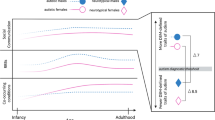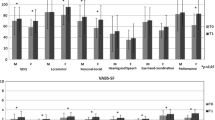Abstract
Despite consistent and substantive research documenting a large male to female ratio in Autism Spectrum Disorder (ASD), only a modest body of research exists examining sex differences in characteristics. This study examined sex differences in developmental functioning and early social communication in children with ASD as compared to children with typical development. Sex differences in adaptive behavior and autism symptoms were also examined in children with ASD. Participants (n = 511) were recruited from the Florida State University FIRST WORDS® Project and University of Michigan Autism and Communication Disorders Center. Analyses did not reveal significant effects of sex or a diagnostic group by sex interaction, suggesting a similar phenotype in males and females early in development. Further research is needed to examine sex differences across development.
Similar content being viewed by others
References
Akhtar, N., & Tomasello, M. (2000). The social nature of words and word learning. In R. Golinkoff & K. Hirsh-Pasek (Eds.), Becoming a word learner: A debate on lexical acquisition. Oxford: Oxford University Press.
American Psychiatric Association. (2013). Diagnostic and statistical manual of mental disorders (Vol. 5). Washington, DC: American Psychiatric Association.
Baird, G., Simonoff, E., Pickles, A., Chandler, S., Loucas, T., Meldrum, D., et al. (2006). Prevalence of disorders of the autism spectrum in a population cohort of children in South Thames: The Special Needs and Autism Project (SNAP). The Lancet, 368(9531), 210–215.
Bussey, K., & Bandura, A. (1999). Social cognitive theory of gender development and differentiation. Psychological Review, 106(4), 676–713.
Carter, A. S., Black, D., Tewani, S., Connolly, C., Kadlec, M. B., & Tager-Flusberg, H. (2007). Sex differences in toddlers with autism spectrum disorders. Journal of Autism and Developmental Disorders,. doi:10.1007/s10803-006-0331-7.
Centers for Disease Control and Prevention. (2014). Prevalence of autism spectrum disorder—Autism and developmental disability monitoring network, 11 sites, United States, 2010. In Surveillance Summary (pp. 1–21). 28, March, 2014. Morbidity and Mortality Weekly Report, 63.
Chakrabarti, S., & Fombonne, E. (2001). Pervasive developmental disorders in preschool children. Journal of the American Medical Association, 285, 3093–3099.
Chawarska, K., Klin, A., Paul, R., Macari, S., & Volkmar, F. (2009). A prospective study of toddlers with ASD: Short-term diagnostic and cognitive outcomes. Journal of Child Psychology and Psychiatry, 50, 1235–1245.
Clarke-Stewart, K. A. (1973). Interactions between mothers and their young children: Characteristics and consequences. Monographs of the Society for Research in Child Development, 38 (6–7, Serial No. 153).
Dale, P. S., Price, T. S., Bishop, D. V. M., & Plomin, R. (2003). Outcomes of early language delay: I. Predicting persistent and transient language difficulties at 3 and 4 years. Journal of Speech, Language, and Hearing Research, 46(3), 544–560.
Dawson, G. (2008). Early behavioral intervention, brain plasticity, and the prevention of autism spectrum disorder. Development and Psychopathology, 20, 775–803.
Faul, F., Erdfelder, E., Buchner, A., & Lang, A. G. (2009). Statistical power analyses using G*Power 3.1: Tests for correlation and regression analyses. Behavior Research Methods, 41, 1149–1160.
Fenson, L., Dale, P. S., Reznick, J. S., Bates, E., Thal, D. J., & Pethick, S. J. (1994). Variability in early communicative development. Monographs of the Society for Research in Child Development, 59 (1, Serial No. 242).
Galsworthy, M. J., Dionne, G., Dale, P. S., & Plomin, R. (2000). Sex differences in early verbal and non-verbal cognitive development. Developmental Science, 3, 206–215.
Giarelli, E., Wiggins, L. D., Rice, C. E., Levy, S. E., Kirby, R. S., Pinto-Martin, J., et al. (2010). Sex differences in the evaluation and diagnosis of autism spectrum disorders among children. Disability and Health Journal, 3(2), 107–116.
Gotham, K., Pickles, A., & Lord, C. (2009). Standardizing ADOS scores for a measure of severity in autism spectrum disorders. Journal of Autism and Developmental Disorders, 39, 693–705.
Gotham, K., Risi, S., Pickles, A., & Lord, C. (2007). The Autism diagnostic observation schedule: Revised algorithms for improved diagnostic validity. Journal of Autism and Developmental Disorders, 37, 613–627.
Hartley, S. L., & Sikora, D. S. (2009). Sex differences in autism spectrum disorders: An examination of developmental functioning, autism symptoms and coexisting behavior problems in toddlers. Journal of Autism and Developmental Disorders, 39, 1715–1722.
Holtman, M., Bolte, S., & Poustka, F. (2007). Autism spectrum disorders: Sex differences in autistic behaviour domains and coexisting psychopathology. Developmental Medicine and Child Neurology, 49, 361–366.
Huttenlocher, J., Haight, W., Bryk, A., Seltzer, M., & Lyons, T. (1991). Early vocabulary growth: Relation to language input and gender. Developmental Psychology, 27, 236–248.
Johnson, C. P., Myers, S. M., & The Council on Children with Disabilities. (2007). Identification and evaluation of children with autism spectrum disorders. Pediatrics, 120(4), 1183–1215.
Kim, Y. S., Leventhal, B. L., Koh, Y. J., Fombonne, E., Laska, E., Lim, E. C., et al. (2011). Prevalence of autism spectrum disorders in a total population sample. [published online May 9, 2011]. American Journal of Psychiatry. doi:10.1176/appi.ajp.2011.10101532.
Kim, S. H., & Lord, C. (2012). Combining information from multiple sources for the diagnosis of autism spectrum disorders for toddlers and young preschoolers from 12 to 47 months of age. Journal of Child Psychology and Psychiatry, 53, 143–151.
Klein, R. P., & Durfee, J. T. (1978). Effects of sex and birth order on infant social behavior. Infant Behavior and Development, 1, 106–117.
Koenig, K., & Tsatsanis, K. (2005). Pervasive developmental disorders in girls. In D. J. Bell, S. L. Foster, & E. J. Mash (Eds.), Handbook of behavioral and emotional problems in girls. New York: Springer.
Kopp, S., & Gillberg, C. (1992). Girls with social deficits and learning problems: Autism, atypical Asperger syndrome or a variant of these conditions. European Child and Adolescent Psychiatry, 1, 89–99.
Leaper, C., Anderson, K. J., & Sanders, P. (1998). Moderators of gender effects on parents’ talk to their children: A meta-analysis. Developmental Psychology, 34, 3–27.
Lord, C. (2011). How common is autism. Nature, 474, 166–168.
Lord, C., Luyster, R., Guthrie, W., & Pickles, A. (2012). Patterns of developmental trajectories in toddlers with autism spectrum disorder. Journal of Consulting and Clinical Psychology, 80(3), 477.
Lord, C., Risi, S., Lambrecht, L., Cook Jr, E. H., Leventhal, B. L., DiLavore, P. C., et al. (2000). The autism diagnostic observation schedule—generic: A standard measure of social and communication deficits associated with the spectrum of autism. Journal of autism and developmental disorders, 30(3), 205–223.
Lord, C., Rutter, M., DiLavore, P., & Risi, S. (1999). Autism diagnostic observation schedule-generic. Los Angeles, CA: Western Psychological Services.
Lord, C., Rutter, M., & Le Couteur, A. (1994). Autism diagnostic interview-revised: A revised version of a diagnostic interview for caregivers of individuals with possible pervasive developmental disorders. Journal of Autism and Developmental Disorders, 24, 659–685.
Lord, C., Schopler, E., & Revicki, D. (1982). Sex differences in autism. Journal of Autism and Developmental Disorders, 12, 317–330.
Luyster, R., Gotham, K., Guthrie, W., Coffing, W., Petrack, R., et al. (2009). The autism diagnostic observation schedule—toddler module: A new module of a standardized diagnostic measure for autism spectrum disorders. Journal of Autism and Developmental Disorders, 39, 1305–1320.
Malatesta, C. Z., & Haviland, J. M. (1982). Learning display rules: The socialization of emotional expression in infancy. Child Development, 53, 991–1003.
Mitchell, S. K. (1979). Interobserver agreement, reliability, and generalizability of data collected in observational studies. Psychological Bulletin, 86(2), 376.
Mullen, E. M. (1995). Mullen scales of early learning (AGS (Edition ed.). Circle Pines: American Guidance Service Inc.
Nicholas, J. S., Charles, J. M., Carpenter, L. A., King, L. B., Jenner, W., & Spratt, E. G. (2008). Prevalence and characteristics of children with autism-spectrum disorders. Annals of Epidemiology, 18, 130–136.
Risi, S., Lord, C., Gotham, K., Corsello, C., Chrysler, C., Szatmari, P., et al. (2006). Combining information from multiple sources in the diagnosis of autism spectrum disorders. Journal of the American Academy of Child and Adolescent Psychiatry, 45, 1094–1103.
Robins, D., Fein, D., Barton, M., & Green, J. (2001). The modified-checklist for autism in toddlers (M-CHAT): An initial investigation in the early detection of autism and Pervasive Developmental Disorders. Journal of Autism and Developmental Disorders, 31, 131–144.
Rosenthal, R. (1991). Meta-analytic procedures for social research (Vol. 6). New Delhi: Sage.
Shattuck, P., Durkin, M., Maenner, M., Newschaffer, C., Mandell, D., Wiggins, L., et al. (2009). Timing of identification among children with an autism spectrum disorder: Findings from a population-based surveillance study. Journal of American Academy of Child & Adolescent Psychiatry, 48(5), 474–483.
Snow, C. E. (1989). Understanding social interaction and language acquisition: Sentences are not enough. In M. H. Bornstein & J. S. Bruner (Eds.), Interaction in human development. Hillsdale, NJ: Erlbaum.
Sparrow, S. S., Cichetti, D. V., & Balla, D. A. (2004). Vineland Adaptive Behavior Scales-Second Edition (Vineland–II). Bloomington, MN: Pearson Assessment.
Stern, M., & Karraker, K. (1989). Modifying the prematurity stereotype: Impact of providing varied information. Journal of Clinical and Social Psychology, 8, 1–13.
Volkmar, F. R., Chawarska, K., & Klin, A. (2005). Autism in infancy and early childhood. Annual Review of Psychology, 6, 315–336.
Volkmar, F. R., Klin, A., Siegel, B., Szatmari, P., Lord, C., Campbell, M., et al. (1994). Field trial for autistic disorder in DSM-IV. American Journal of Psychiatry, 151, 1361–1367.
Wetherby, A. M., Allen, L., Cleary, J., Kublin, K., & Goldstein, H. (2002). Validity and reliability of the Communication and Symbolic Behavior Scales Developmental Profile with very young children. Journal of Speech, Language and Hearing Research, 45, 1202–1218.
Wetherby, A. M., Brosnan-Maddox, S., Peace, V., & Newton, L. (2008). Validation of the Infant-Toddler Checklist as a broadband screener for autism spectrum disorders from 9 to 24 months of age. Autism, 12, 487–511.
Wetherby, A. M., & Prizant, B. (2002). Communication and symbolic behavior scales developmental profile-first (normed ed.). Baltimore, MD: Paul H. Brookes.
Wing, L., & Gould, J. (1979). Severe impairments of social interaction and associated abnormalities in children: Epidemiology and classification. Journal of Autism and Developmental Disorders, 9, 11–29.
Yirmiya, N., & Ozonoff, S. (2007). The very early phenotype of autism. Journal of Autism and Developmental Disorders, 37, 1–11.
Zwaigenbaum, L., Bryson, S., Szatmari, P., Brian, J., Smith, I.M., Roberts, W. et al. (2012). Sex differences in children with autism spectrum disorder identified within a high-risk infant cohort. Journal of Autism and Developmental Disorders, 2. doi:10.1007/s10803-012-1515-y.
Acknowledgments
This research was supported in part by NICHD R01HD065272, NIDCD R01DC007462, and CDC U01DD000304 awarded to Amy M. Wetherby. Vanessa P. Reinhardt was supported in part by grant UA3 MC 11055 AIR-B from the Maternal and Child Health Research Program, Maternal and Child Health Bureau (Combating Autism Act Initiative), Health Resources and Services Administration, Department of Health and Human Services. The content is solely the responsibility of the authors and does not necessarily represent the official views of the NICHD, NIDCD, the NIH, or the CDC. This paper was based on Vanessa Reinhardt’s Masters thesis.
Conflict of interest
Amy M. Wetherby receives royalties for the CSBS. Catherine Lord receives royalties for the ADOS and ADOS-T from Western Psychological Services.
Author information
Authors and Affiliations
Corresponding author
Rights and permissions
About this article
Cite this article
Reinhardt, V.P., Wetherby, A.M., Schatschneider, C. et al. Examination of Sex Differences in a Large Sample of Young Children with Autism Spectrum Disorder and Typical Development. J Autism Dev Disord 45, 697–706 (2015). https://doi.org/10.1007/s10803-014-2223-6
Published:
Issue Date:
DOI: https://doi.org/10.1007/s10803-014-2223-6




